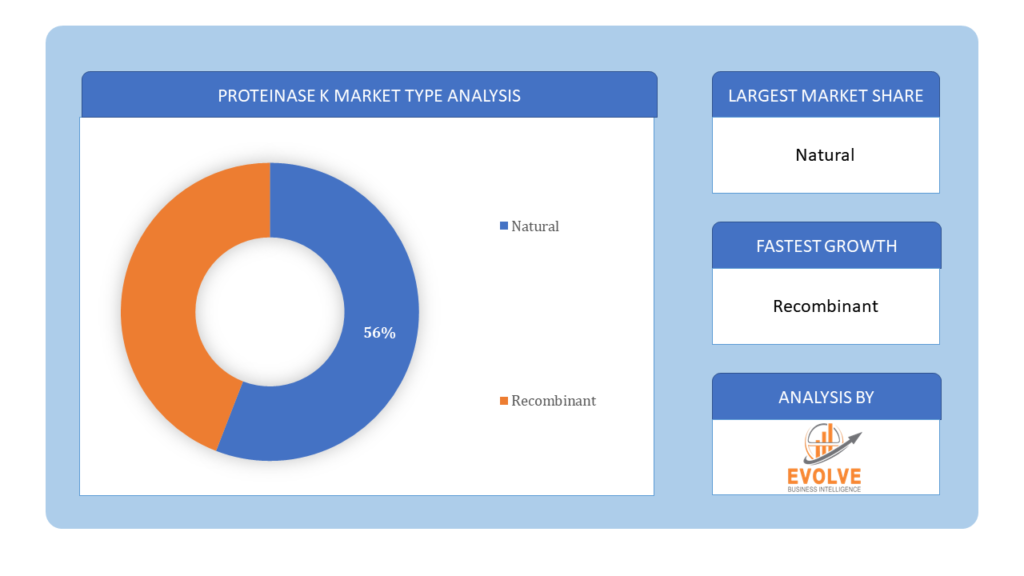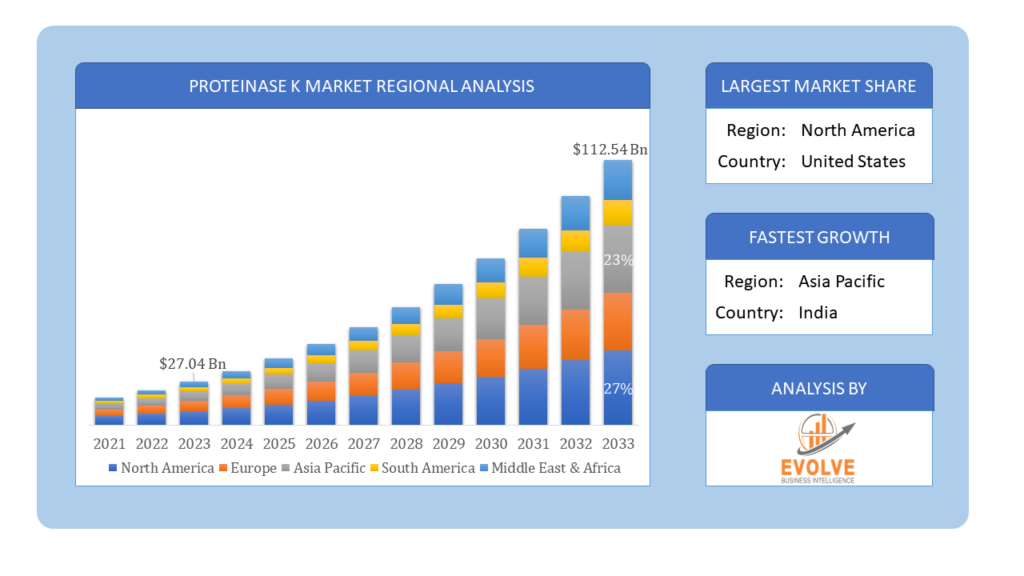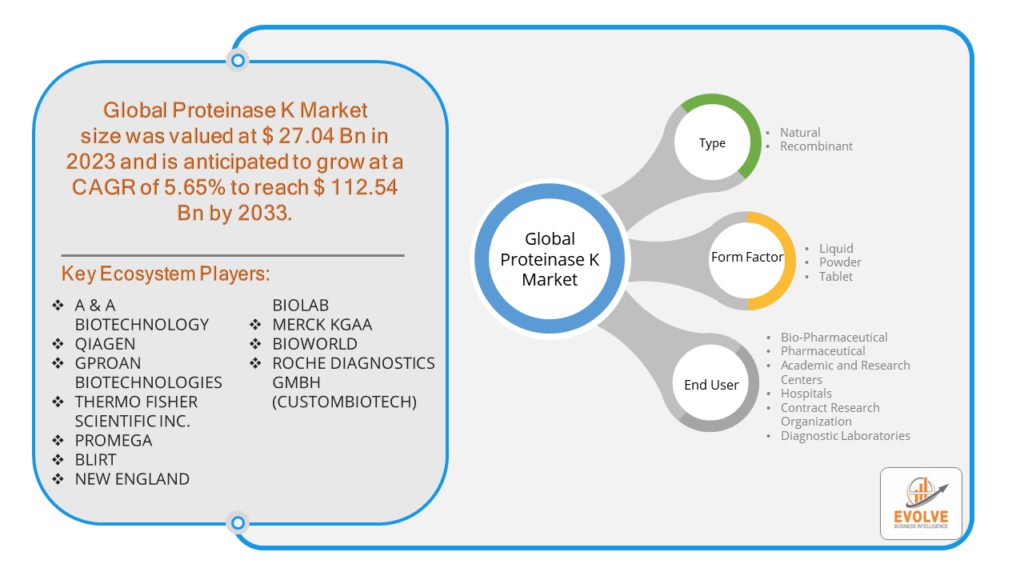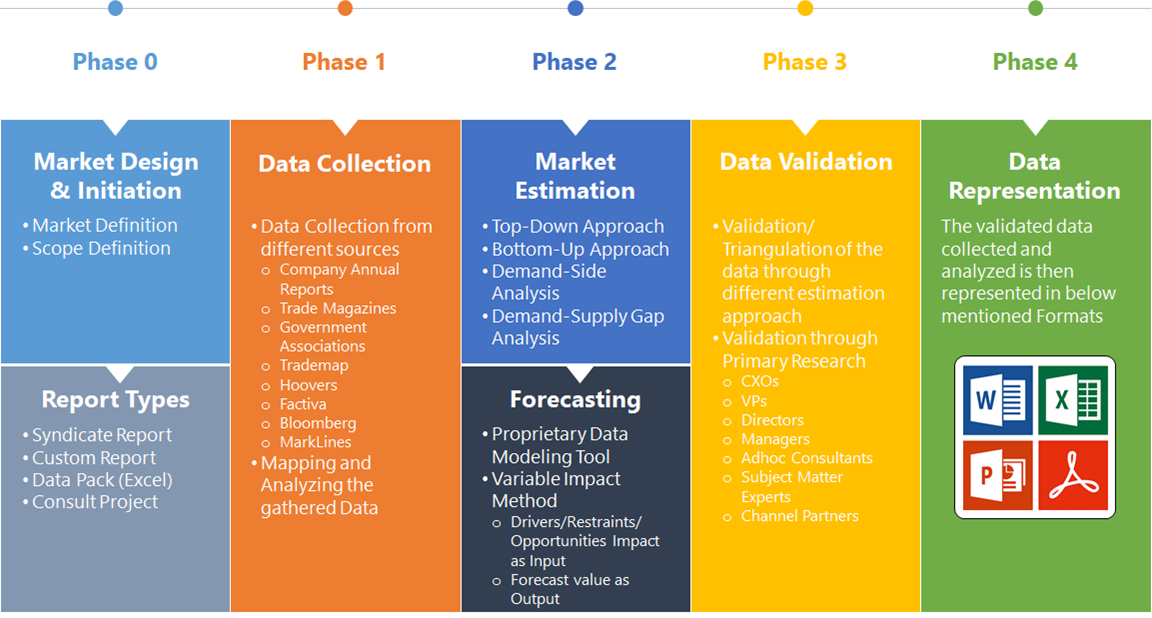Proteinase K Market Overview
The Proteinase K Market Size is expected to reach USD 112.54 Billion by 2033. The Proteinase K industry size accounted for USD 27.04 Billion in 2023 and is expected to expand at a compound annual growth rate (CAGR) of 5.65% from 2023 to 2033. Proteinase K is a highly stable and broad-spectrum serine protease derived from the fungus Tritirachium album. It is widely used in molecular biology and biotechnology for its ability to digest a variety of proteins, including those resistant to other proteases, such as native proteins, nucleases, and other enzymes. Proteinase K is particularly valuable in DNA and RNA extraction protocols, where it helps to remove protein contaminants and ensure high-quality nucleic acid purification. Its robustness allows it to function effectively across a wide range of temperatures and pH levels, making it an essential tool in genetic research, clinical diagnostics, and various industrial applications.
Global Proteinase K Market Synopsis
The COVID-19 pandemic has caused significant supply chain disruptions in the Proteinase K market, resulting in supply shortages and fluctuating demand. These disruptions impacted the production and distribution of Proteinase K, hindering its availability for various applications in molecular biology and biotechnology. Concurrently, lower demand from certain sectors due to halted research activities and reduced operational capacities further influenced the market dynamics during the pandemic.
Proteinase K Market Dynamics
The major factors that have impacted the growth of Proteinase K are as follows:
Drivers:
Ø Growing Demand for Genetic Research and Biotechnology
The increasing focus on genetic research and biotechnology applications, including DNA and RNA extraction, forensic analysis, and pharmaceutical development, drives the demand for Proteinase K. Its essential role in ensuring high-quality nucleic acid purification makes it indispensable in these fields.
Restraint:
- Supply Chain Disruptions
Frequent supply chain disruptions, as seen during the COVID-19 pandemic, pose a significant restraint in the Proteinase K market. These disruptions can lead to shortages, increased costs, and delays in product availability, affecting research and industrial processes reliant on this enzyme.
Opportunity:
⮚ Advancements in Molecular Diagnostics
The rapid advancements in molecular diagnostics, particularly in personalized medicine and disease diagnostics, present a significant opportunity for the Proteinase K market. As these technologies evolve, the demand for efficient and reliable enzymes like Proteinase K for sample preparation and analysis is expected to rise, driving market growth.
Proteinase K Segment Overview
By Type
 Based on Type, the market is segmented based on Natural, Recombinant. The natural segment dominates the Proteinase K market due to its superior stability and effectiveness in various applications, including genetic research and biotechnology. Its ability to function across a wide range of temperatures and pH levels makes it highly preferred for consistent and reliable results.
Based on Type, the market is segmented based on Natural, Recombinant. The natural segment dominates the Proteinase K market due to its superior stability and effectiveness in various applications, including genetic research and biotechnology. Its ability to function across a wide range of temperatures and pH levels makes it highly preferred for consistent and reliable results.
By Form Factor
Based on Form Factor, the market has been divided into the Liquid, Powder, Tablet. The liquid segment dominates the Proteinase K market due to its ease of handling, accurate dosing, and compatibility with various sample types, facilitating efficient enzymatic digestion processes. Liquid formulations offer convenience and flexibility in laboratory workflows, making them preferred for a wide range of applications in molecular biology and biotechnology.
By End User
Based on End User, the market has been divided into the Bio-Pharmaceutical, Pharmaceutical, Academic and Research Centers, Hospitals, Contract Research Organization, Diagnostic Laboratories. The Bio-Pharmaceutical segment dominates the Proteinase K market due to its extensive use in drug development, protein analysis, and molecular biology applications, essential for creating innovative therapeutics. This dominance is further supported by the segment’s role in advancing personalized medicine and biotechnological research.
Global Proteinase K Market Regional Analysis
Based on region, the global Proteinase K market has been divided into North America, Europe, Asia-Pacific, the Middle East & Africa, and Latin America. North America is projected to dominate the use of the Proteinase K market followed by the Asia-Pacific and Europe regions.
 Proteinase K North America Market
Proteinase K North America Market
North America holds a dominant position in the Proteinase K market, primarily driven by a robust biotechnology and pharmaceutical industry, significant investments in research and development, and a well-established healthcare infrastructure. The region benefits from a high concentration of leading biotech firms, research institutions, and a strong regulatory framework that supports innovative medical research and diagnostics. Additionally, the demand for proteinase K in various applications such as nucleic acid extraction, molecular biology, and diagnostic testing is bolstered by the growing prevalence of chronic diseases and the ongoing advancements in genomic and proteomic research. This combination of factors contributes to North America’s leading role in the global Proteinase K market.
Proteinase K Asia-Pacific Market
The Asia-Pacific region has indeed emerged as the fastest-growing market for the Proteinase K industry, driven by rapid advancements in biotechnology, increasing healthcare expenditures, and expanding research activities in countries like China, India, and Japan. The region’s growth is further fueled by a burgeoning pharmaceutical sector, rising prevalence of chronic diseases, and increasing investments in genomic and proteomic research. Additionally, supportive government initiatives and the establishment of numerous research institutions and biotech companies contribute to the dynamic expansion of the Proteinase K market in the Asia-Pacific region. This growth trajectory is supported by a growing focus on personalized medicine and molecular diagnostics, positioning Asia-Pacific as a significant player in the global Proteinase K market.
Competitive Landscape
The global Proteinase K market is highly competitive, with numerous players offering a wide range of software solutions. The competitive landscape is characterized by the presence of established companies, as well as emerging startups and niche players. To increase their market position and attract a wide consumer base, the businesses are employing various strategies, such as Activity launches, and strategic alliances.
Prominent Players:
- A & A BIOTECHNOLOGY
- QIAGEN
- GPROAN BIOTECHNOLOGIES
- THERMO FISHER SCIENTIFIC INC.
- PROMEGA
- BLIRT
- NEW ENGLAND BIOLAB
- MERCK KGAA
- BIOWORLD
- ROCHE DIAGNOSTICS GMBH (CUSTOMBIOTECH)
Scope of the Report
Global Proteinase K Market, by Type
- Natural
- Recombinant
Global Proteinase K Market, by Form Factor
- Liquid
- Powder
- Tablet
Global Proteinase K Market, by End User
- Bio-Pharmaceutical
- Pharmaceutical
- Academic and Research Centers
- Hospitals
- Contract Research Organization
- Diagnostic Laboratories
Global Proteinase K Market, by Region
- North America
- US
- Canada
- Mexico
- Europe
- UK
- Germany
- France
- Italy
- Spain
- Benelux
- Nordic
- Rest of Europe
- Asia Pacific
- China
- Japan
- South Korea
- Indonesia
- Australia
- Malaysia
- India
- Rest of Asia Pacific
- South America
- Brazil
- Argentina
- Rest of South America
- Middle East & Africa
- Saudi Arabia
- UAE
- Egypt
- South Africa
- Rest of Middle East & Africa
| Parameters | Indicators |
|---|---|
| Market Size | 2033: $112.54 Billion/strong> |
| CAGR | 5.65% CAGR (2023-2033) |
| Base year | 2022 |
| Forecast Period | 2023-2033 |
| Historical Data | 2021 |
| Report Coverage | Revenue Forecast, Competitive Landscape, Growth Factors, and Trends |
| Key Segmentations | Type, Form Factor, End User |
| Geographies Covered | North America, Europe, Asia-Pacific, Latin America, Middle East, Africa |
| Key Vendors | A & A BIOTECHNOLOGY, QIAGEN, GPROAN BIOTECHNOLOGIES, THERMO FISHER SCIENTIFIC INC., PROMEGA, BLIRT, NEW ENGLAND BIOLAB, MERCK KGAA, BIOWORLD, ROCHE DIAGNOSTICS GMBH (CUSTOMBIOTECH) |
| Key Market Opportunities | • Growth potential in emerging markets, especially in Asia-Pacific. • Increasing focus on personalized medicine and targeted therapies. • Technological advancements in proteinase K production and application |
| Key Market Drivers | • Increasing demand for advanced diagnostic techniques. • Growing biotechnology and pharmaceutical industries. • Rising prevalence of chronic diseases requiring complex diagnostic procedures |
REPORT CONTENT BRIEF:
- High-level analysis of the current and future Proteinase K market trends and opportunities
- Detailed analysis of current market drivers, restraining factors, and opportunities in the future
- Proteinase K market historical market size for the year 2021, and forecast from 2023 to 2033
- Proteinase K market share analysis at each Activity level
- Competitor analysis with detailed insight into its Activity segment, Government & Defense strength, and strategies adopted.
- Identifies key strategies adopted including Activity launches and developments, mergers and acquisitions, joint ventures, collaborations, and partnerships as well as funding taken and investment done, among others.
- To identify and understand the various factors involved in the global Proteinase K market affected by the pandemic
- To provide a detailed insight into the major companies operating in the market. The profiling will include the Government & Defense health of the company’s past 2-3 years with segmental and regional revenue breakup, Activity offering, recent developments, SWOT analysis, and key strategies.





